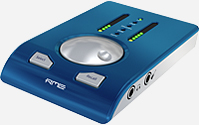Table of Contents
RME Babyface
General
 The RME Babyface is a USB 2.0 interface with:
The RME Babyface is a USB 2.0 interface with:
- 2 x Analog Input
- 4 x Analog Output (including headphone channels)
- 10 Input / 12 Output channels (including ADAT channels)
- 1 x ADAT I/O or 1 x SPDIF I/O optical
- 1 x MIDI I/O
- 1 x USB 2.0
- 2 x Mic Preamp with digitally controlled gain
- 1 x Hi-Z instrument input
- TotalMix FX (with EQ via internal DSP, Reverb, Echo).
Support
Class compliant via new firmware (version 200). In CC (Class Compliant) mode the Babyface should work out of the box without having to use a patched kernel. This is contrary to the Fireface UCX, with which the Babyface shares its internals, which does need a patch 1).
When plugged in ALSA should recognize the Babyface as follows with a recent kernel:
$ cat /proc/asound/cards | grep -i baby
1 [Babyface2359686]: USB-Audio - Babyface (23596862)
RME Babyface (23596862) at usb-0000:00:14.0-2, high speed
Because the device can only be used in CC mode the Linux Support Rating is 2.
JACK Settings
According to the RME site:
“The Babyface achieves latency values down to 48 samples on Windows and 14 samples on Mac OS X.2)
On Linux the Babyface runs well at 32 samples:
/usr/bin/jackd -P79 -t2000 -dalsa -dhw:B23596862 -r48000 -p32 -n2 -s
Using lower periods settings is possible too, the device starts and runs when using 8 samples for example but basically anything below 64 samples is not very usable because you quickly run into buffer issues (xruns). Linux does beat the other two OS's though when it comes to buffer sizes but unfortunately this doesn't result in better round-trip latencies, especially when compared to MacOS.
TotalMix FX and DSP
TotalMix and the internal DSP can't be used in CC (Class Compliant) mode so these options are not available when using the Babyface with Linux.
Switching to Class Compliant mode
Hold down the Select and Recall buttons simultaneously while connecting the Babyface to an USB port. If the level meters run up the interface is in CC mode. Repeating this procedure will put the interface back in normal mode again. In normal mode only one LED of each meter will light up when powering on the Babyface. When in normal mode the interface won't be recognized on a Linux system.
References
- RME forum on new firmware November 2012